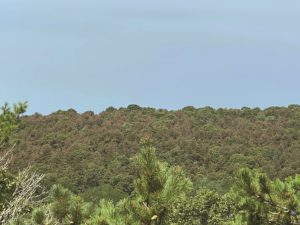TRURO — From her house on a hill near Higgins Hollow and Longnook Beach, Melinda Krasting has a clear view of a patch of pitch pines that are slowly turning brown.
“I’ve been looking at this hill for seven years, and I’ve never seen anything like this,” said Krasting, worried. “It’s more brown than green now.”
While experts from the National Park Service acknowledge that a patch of browning pines like this one may be new, they also say it’s not actually a cause for concern.
“There’s no shortage of pine trees on the Cape,” said NPS plant ecologist Stephen Smith. And, he added, when patches of trees die here, they tend to be relatively small stands.
There’s no one reason why pines turn brown, either. “There are lots of reasons pines will die,” said Smith. “Gall wasps, turpentine beetles, drought, or salting along the roads during winters.” Of all the possibilities, “I think southern pine beetles are our biggest concern right now,” he said.
“We’re expecting a wave of the pine beetles,” Smith said. “Then there’s a probability that we’ll get new plant pests moving here with climate change.”
The southern pine beetle, or Dendroctonus frontalis, is a relatively new plant pest on the Cape, whose spread up the East Coast over the last decade was enabled by warming temperatures and climate change. The pine beetle must kill its host tree in order to reproduce. They swarm trees en masse in order to cause their damage. The species is the most destructive forest insect pest in the U.S.
Making Way for Heathlands
If pines are facing adversity from so many different angles, why shouldn’t we be concerned?
“It’s not necessarily a bad thing when patches of forest die and become open,” answered Smith. These areas are known as heathlands.
According to the NPS, “Heathlands are areas where low growing shrub species dominate the vegetation cover.” Species of plants and animals native to the Cape rely on heathlands as a habitat, and Smith said there isn’t enough of it left.
“There are very few open spaces left on the Cape. In the Seashore, we’re actually cutting down and burning out many acres of pine in order to restore the heathland,” he said. “The reason we want to do that is because much of the heathland up and down the coast has been lost to development.”

At the same time, Smith said, forest species are moving back in, a change taking place naturally in the Cape’s forests and transforming them into something more like they were in the distant past.
National Seashore geographic information specialist and coastal geologist Mark Adams noted the landscape we see today is the closest it’s been to Cape Cod’s natural look since the Pilgrims arrived.
“The Europeans came to Cape Cod in the 1600s, and by the mid 1700s, they had cut down all the forests,” said Adams. “They also started a lot of fires.”
Thanks to that pattern of destruction, it’s only recently that the trees have been allowed to take back their spots in undeveloped land, creating what Adams called “closed canopy forest.”
“Now,” Adams said, “there’s a habitat that didn’t exist for 300 years. That’s why we’re seeing more fisher cats, coyotes, and other animals,” he added.
What About Fire Safety?
But while the withering pines may be no cause for alarm in the greater environmental context, they do raise concerns about fire safety. “Especially where there’s a lot of dead trees, sometimes we have a hazardous situation,” said Adams. “The nor’easters bring ice and snow in the spring, and it breaks lots of branches and creates fuel on the ground.”
“Anytime there’s lots of dead vegetation, fires will have fuel,” agreed Smith.
Fortunately, the Cape and the National Seashore have experience with that, too.
“There’s a history of fire here,” said Adams. “Between one and two thousand years ago, the native people would use controlled ground fires to clear out the understory. There was a fire regime on the Cape by humans.”
The railroad the Europeans built brought its own troubles, though. “When you look at the reports,” said Adams, “the railroad made big payments to the towns for all the fires it caused. There wasn’t much forest left then, but those fires were a big factor.”
That’s a reason to not completely dismiss the pine die-offs. They create fuel.
The National Seashore has its own fire management office and winter and summer fire crews, with a focus on both management and safety when it comes to wildland fires. Adams believes the Seashore has a good grasp on the situation.
“We have really good fire suppression, and standards for fire reduction around buildings,” he said. “The last real major fire we had was in the 1950s. We’re doing some burning experiments, both to manage hunted species (like keeping an open habitat for quail) and to reduce hazards for fire. And also, to keep certain places as undeveloped cultural landscapes.”
Watching patches of forest turn brown, it turns out, means watching pests, drought, and the Outer Cape’s harsh elements in action. There is cause for caution when it comes to fire. But it also means seeing the landscape’s evolution and potential restoration underway.
